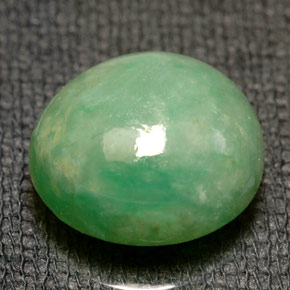The Gemstone Jade

Jade is best known as a green ornamental stone. Its colors varies from light to dark green, but it may also be other colors such as white, gray, and purple. Jade is actually the gemstone name for two different mineral forms, Jadeite and Nephrite. These two minerals can be identical in appearance and are similar in their physical properties, and until modern times no distinction was made between the two different types of Jade. While Nephrite is generally only green, cream, or white, Jadeite colors can range through the color spectrum with more exotic colors.
Color
?
White, Blue, Red, Green, Yellow, Orange, Brown, Pink, Purple, Gray, Black, Banded, Multicolored
Chemical Formula
?
Nephrite: Ca
2(Mg,Fe)
5Si
8O
22(OH)
2
Jadeite: NaAlSi
2O
6
Mineral Class
?
Jadeite or
Nephrite (Nephrite can be either
Actinolite or
Tremolite)
Additional Properties
|
Refractive Index
?
1.60 - 1.67 |
Double Refraction
?
-0.027 (Nephrite); 0.013 (Jadeite) |
Transparency
?
Translucent to opaque |
SG
?
2.9 - 3.7 |
Luster
?
Waxy, vitreous |
| Cleavage ?
1 or 2,2 - prismatic. Due to lack of visible crystals, cleavage is rarely observed. |
All About
Jade has been an important gemstone throughout history, especially among the Chinese and Latin American cultures. Ancient carved figures have been found from these societies, where the value of Jade was sometimes worth even more than of
Gold.
The name Jade is derived from the Spanish phrase "Piedra de Ijada", which means "Stone of the Hip", as this stone was used as a metaphysical protection against kidney disease by the ancient societies.
Jadeite is composed tightly packed microscopic crystals, and Nephrite is composed of extremely dense mineral
fibers that are interlocked and very tough. Of the two Jade forms, Nephrite is more softer and more prone to scratches, and Jadeite is not as dense and is more prone to chipping. Of the two, Nephrite is the more common form. Jadeite is becoming increasingly difficult to obtain due to a trade embargo emplaced by the U.S. against Mynamar (Burma), the primary source of Jadeite.
Jade gemstones are often multicolored or mottled. A white and light green color combination is a very common form, and darker stones usually have black mottling. Uniformly colored stones are less common. Deeper colored stones are more valuable, and the most valuable form is called
Imperial Jade, which is emerald-green in color and translucent.
Uses
?
Jade is most often polished into
cabochons and beads, and is used in bracelets, necklaces, rings, and earrings. Ornamental figures, especially animals and Buddhas, have traditionally been carved from Jade. Jade is also carved into ornate engraved pendants and
cameos. Rings and bracelets are sometimes carved out of an entire mass of Jade.
False Names
?
Many translucent to opaque greenish stones have been given a trade name of "Jade" with some sort of prefix. The list below describes some commonly seen names, though there are no doubt many more with some made up by individual dealers.
Amazon Jade - Green
Amazonite.
Australian Jade - Green
Quartz such as
Aventurine.
Colorado Jade - Green
Amazonite.
Indian Jade - Green
Quartz such as
Aventurine.
Jasper Jade -
Jasper with a greenish color.
Korean Jade - Any Jade simulant, especially Green
Quartz such as
Aventurine.
Oregon Jade -
Jasper with a greenish color that originates in Oregon.
African Jade, Garnet Jade, South African Jade, Transvaal Jade -
Massive veins of opaque
Hydrogrossular Garnet that resembles
Jade. It is white to light green in color, and may be colored in a
white, green, and pink combination.
Treatments & Enhancements
?
The color of Jade is usually natural, although some stones may be artificially
dyed to a deeper green color. Beeswax and synthetic lubricants are sometimes used to fill microscopic
surface pores within a Jade as well as enhance surface luster.
Jade Sources
?
The main deposits of Jadeite are in Mynamar (Burma); other deposits are in China (Tibet), Russia, Kazakhstan, Guatemala, and the U.S. (California). Nephrite Jade comes from China, Russia, Brazil, and the United States (
Wyoming, Alaska, and California).
Similar Gemstones
?
Amazonite and Aventurine- Usually have different texture of color pattern, and color not as smooth.
Emerald - Harder, usually deeper green and more transparent, never multicolored or mottled
Chrysoprase - Usually more apple-green in color and slightly harder, always uniform in color.
Serpentine - Much softer, has a greasy feel.
Jade in the Rough Photos
?